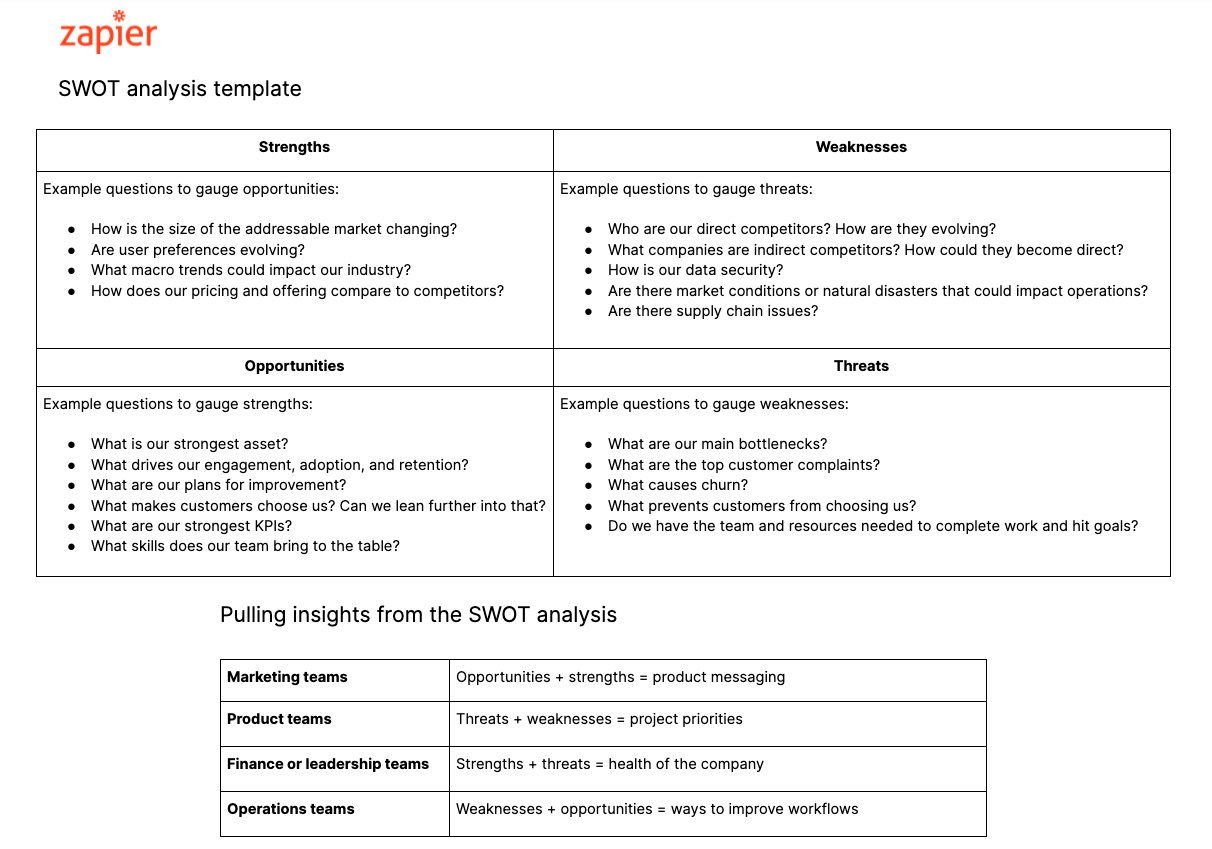Listen, I get it. The moment you hear “SWOT analysis,” you start to tune out, think about what’s for lunch today, and hope this discussion will be over soon. It makes sense, seeing as the only time most of us encounter SWOT is in some boring business textbook or on a vanilla LinkedIn post from a well-meaning manager named Craig.
While SWOT has a bland reputation, there’s a reason businesses have used it for nearly 60 years. It’s time to reclaim the strategy as something less snooze-worthy.
What is a SWOT analysis?
A SWOT analysis gives businesses a way to gauge their current business, in order to plan for the future. It’s all about context, considering the positive and negative forces that a company contends with internally and externally.
Streamline your business operations
Think of a SWOT analysis as a way to read the room, so you can make informed decisions. If you’ve ever prepped for a family gathering by tallying which cousins will be in attendance and what world events your uncle might rattle on, you’ve done a SWOT analysis.
When you should (and shouldn’t) use SWOT
A SWOT analysis helps you understand your business and how it exists in context. That’s powerful stuff, but it doesn’t mean you should lean on this method in every scenario.
When to use SWOT analysis
-
You need a high-level view. You can apply SWOT to your entire company or narrow in on a niche, market, or department. Whichever level you choose, the analysis gives you a broad picture of conditions.
-
You have research to include. Your analysis will stand on firmer ground with quantitative or qualitative insights.
-
You need to decide on positioning (or prepare to pivot). Because SWOT looks internally and externally, it’s helpful when you need to make big guiding decisions. Combining your competitors’ shortcomings with your strengths is also an excellent product positioning opportunity.
When to skip the SWOT
-
You’re the only one working on it. The point is to identify positives and negatives you aren’t already aware of. You won’t get the full effect if you create in a vacuum. Instead, get input from a diverse set of stakeholders across departments.
-
You want to understand one issue deeply. SWOT goes wide. It can tip you off to significant trends, but if you want to make a really specific decision, you’ll need to go on a side quest.
-
You don’t have a clear reason to do it. There needs to be something to prompt the SWOT, or else you may get lost in too many details. If there’s a new competitor, your business is going in a new direction, or you’re trying to understand why growth is stagnant, a SWOT makes sense. Otherwise, considering every contributing element could get overwhelming. You could use SWOT as part of an annual checkup, but it would still be helpful to have a few specific questions, goals, or concerns in mind.
SWOT analysis template
Use this SWOT template as a starting point. It includes guiding questions to follow and suggestions for how to pull actionable insights from your analysis. Then follow along with the example below to get a better sense of how to fill it out.

SWOT analysis example
A SWOT analysis is straightforward at the surface level. There are four boxes: one each for company strengths, weaknesses, opportunities, and threats.
The Harvard Business Review recommends looking externally first because that will give you more context to the relevance of everything internal. If you follow that method, you’ll fill out the O and T boxes before S and W.
I’m going to fill out the SWOT template with an example company to show the process in action. The example business, Midsize, Inc., is a team collaboration app.
1. Gather your intel
Compiling supporting data first makes it quicker to plug ideas into the template. Review project plans, check reports, analyze performance, or browse competitor websites.
Let’s assume Midsize, Inc. has the following info handy:
-
Survey results to track user opinions
-
In-product analytics that reveal frustrating UX
-
A pricing comparison chart in a competitive analysis report
From here, I’ll follow Harvard’s advice and start the SWOT analysis from the outside.
2. Opportunities
Opportunities are conditions within your industry or niche that you can capitalize on. You don’t need to take advantage of all of them, but seeing your options laid out can help you prioritize big initiatives.
Here are some example questions to gauge opportunities:
-
How is the size of the addressable market changing?
-
Are user preferences evolving?
-
What macro trends could impact our industry?
-
How do our offerings and pricing compare to competitors?
In Midsize, Inc.’s case, the shift to remote work was a major industry change. Only 20% of U.S. adults telecommuted before the coronavirus outbreak, but the trend is here to stay, and 97% of workers want at least some remote work going forward. Opportunities for the company could be:
-
Adding features that help with planning and collaboration for teams that spend some days in the office and others at home
-
Pricing below competitors to target lower-budget companies who still need to deal with hybrid work; or leaning into advanced features and charging more
3. Threats
Threats are ways that the competition could encroach on your market share. These generally fall into three camps: new competitors, competitor advancements, and industry trends.
Example questions to gauge threats include:
-
Who are our direct competitors? How are they evolving?
-
What companies are indirect competitors? How could they become direct?
-
How is our data security?
-
Are there market conditions or natural disasters that could impact operations?
-
Are there supply chain issues?
While Midsize, Inc. has enjoyed helping more teams collaborate remotely, there’s a looming issue on the horizon—the Great Resignation. Some of the ways this could impact them include:
-
Varying revenue as the number of seats a company pays for fluctuates
-
Employee pushback on work culture or projects that aren’t conducive to a healthy work/life balance
-
A strong marketing campaign boosted a competitor’s market share
4. Strengths
After getting a sense of what’s going on around your business, it’s time for self-reflection. Strengths are ways your company stands out from the competition and meets customer needs.
Example questions to gauge strengths include:
-
What is our strongest asset?
-
What drives our engagement, adoption, and retention?
-
What are our plans for improvement?
-
What makes customers choose us? Can we lean further into that?
-
What are our strongest KPIs?
-
What skills does our team bring to the table?
Midsize, Inc. makes data-informed product and marketing decisions that give them a few competitive advantages, including:
-
High activation rates thanks to excellent customer onboarding
-
A new CEO who wants to focus on user satisfaction and retention
-
A growing product management team
5. Weaknesses
The final component of the SWOT analysis is your company’s shortcomings. Weaknesses are areas where your company falls short of customer expectations or operational efficiency.
Example questions to gauge weaknesses include:
-
What are our main bottlenecks?
-
What are the top customer complaints?
-
What causes churn?
-
What prevents customers from choosing us?
-
Do we have the team and resources needed to complete work and hit goals?
Like all companies, Midsize, Inc. has constraints that teams contend with. Their weaknesses include:
Now what? Making decisions based on your SWOT
Simply filling out a SWOT analysis template might give you clarity on a problem you’ve been trying to solve. But the application of a SWOT analysis might not look the same for every team.
For example:
-
The marketing team could combine opportunities and strengths to find new messaging.
-
The product management team could combine threats and weaknesses to prioritize additions or improvements.
-
The finance team or leadership might weigh strengths versus threats to gauge the company’s health.
-
The operations team can combine weaknesses and opportunities to improve workflows.
No matter which segments pertain to your team, try to summarize a few takeaways at the end of the analysis. For our example company, Midsize, Inc., a takeaway could be refactoring pricing tiers to meet user needs and capitalize on industry opportunities, or adding more automation to their workflows to help with marketing bottlenecks.
A SWOT analysis can feel like a tool you have to fill out, but try reframing it as something you get to leverage. Working with teammates helps you gain a comprehensive view, and summarizing what you learn into actionable takeaways makes the whole process feel worthwhile. And if you don’t think it’ll help—just skip it. This isn’t business school.
[adsanity_group align=’alignnone’ num_ads=1 num_columns=1 group_ids=’15192′]
Need Any Technology Assistance? Call Pursho @ 0731-6725516







